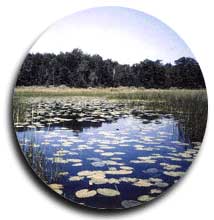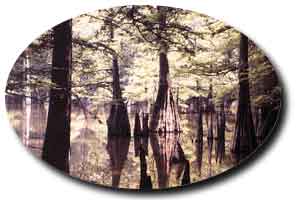| |
Among the most biologically productive lands, wetlands cover approximately 4 to 6 percent of the Earth’s land surface. The high productivity results from the essential characteristic of a wetland: an area that is flooded part of the time but not all of the time. This flooding ensures that the wetlands have ample supplies of water, minerals, or both. In addition to the high biological productivity, wetlands are important habitat for birds, fish, and other species. Wetlands are also important cleansing mechanisms for preventing pollutants from farms and other activities from running off and polluting rivers, lakes, and streams.

Wetlands can be broadly divided into two categories: coastal wetlands and inland wetlands. Coastal wetlands are mostly marshes and swamps that are flooded by the tides; but they also include some non-tidal freshwater wetlands which are at sea level but too far inland to be influenced by the tides. See Coastal Zones for a discussion of impacts of climate change on coastal wetlands.
Non-tidal inland wetlands include wetlands along rivers and lakes, as well as isolated wetlands that are not directly connected to a major body of water. Along open water bodies, marshes and swamps are regularly flooded, while bottomland hardwoods form in floodplains. Isolated wetlands such as peatlands often occur in areas where small ponds have formed because the land surface is below the water table at least part of the year. An important example is the "prairie pothole," which provides habitat for about half of the U.S. waterfowl population.
The impact of climate change on non-tidal wetlands is uncertain, because it depends on changes in the amount of rainfall, as well as when it occurs, which scientists are unable to forecast (see U.S. Climate in the Future Climate section). In those areas where the climate becomes drier, drought will tend to lower water tables more than the lowering that occurs during droughts today. The resulting effect on prairie potholes would be similar to what happens today when farmers drain the wetlands. (See the EPA Wetlands Office site for more information.) The open water ponds, which are critical habitat for waterfowl, would be replaced by relatively damp land, although some form of wetland vegetation would remain.
Lower water tables would also leave areas that currently have some form of wetland vegetation dry for a longer part of the year, which would reduce biological productivity and in some cases leave the land too dry to be considered a wetland. A drier climate could also lead farmers to increase their use of irrigation, which could further lower groundwater tables and indirectly drain the prairie potholes. A wetter climate would have the opposite effect.
 Changing climate could increase or decrease the prevalence of riverside marshes and floodplain vegetation. If precipitation increases, or if rainstorms become more severe, the resulting increase in flooding may increase the area where floodplain wetlands could form. If runoff were to increase the amount of siltation, then additional marshes may form in some rivers and lakes. Changing climate could increase or decrease the prevalence of riverside marshes and floodplain vegetation. If precipitation increases, or if rainstorms become more severe, the resulting increase in flooding may increase the area where floodplain wetlands could form. If runoff were to increase the amount of siltation, then additional marshes may form in some rivers and lakes.
The eventual effect of climate change, however, may also depend on how people respond to the increased flood risk. If people respond by moving out of hazardous areas, there will be more undeveloped land in the floodplain where wetlands can form. If people respond by building dams, river levees, or other structures to prevent floods, both the structures and the decline in flooding will decrease the total area where floodplain wetlands can form.
| |
|